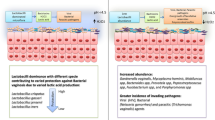Abstract
The facultative and strictly anaerobic vaginal microbial flora was investigated in 40 women with non-specific vaginitis and in 40 control women seen in private gynaecological practice.Gardnerella vaginalis, anaerobic gram-negative bacilli, anaerobic gram-negative and gram-positive cocci were all associated with non-specific vaginitis (p<0.001), whereas lactobacilli occurred less frequently in non-specific vaginitis than in controls (p<0.01). The most common anaerobes wereVeillonella parvula, Bacteroides bivius, Bacteroides assaccharolyticus, Bacteroides capillosus andPeptococcus asaccharolyticus. Anaerobic gram-negative curved rods were found in 11% of cases of non-specific vaginitis. A characteristic pattern of short chain organic acids was found on gas liquid chromatographic analysis of vaginal secretions in non-specific vaginitis. A succinate/lactate peak ratio of 0.3 or more was found in 75% of women with non-specific vaginitis (p<0.001). Clue cells, a Positive amine test, a pH higher than 5.0, and the absence of lactobacilli on a Gram stained vaginal smear strongly correlated with non-specific vaginitis (p<0.001).
Similar content being viewed by others
References
Gardner, H. L., Dukes, C. D.:Haemophilus vaginalis vaginitis. A newly defined specific infection previously classified “non-specific” vaginitis. American Journal of Obstetrics and Gynaecology 1955, 69: 962–976.
McCormack, W. M., Hayes, C. H., Rosner, B., Evrard, J. R., Crockett, V. A., Alpert, S., Zinner, S. H.: Vaginal colonization withCorynebacterium vaginale (Haemophilus vaginalis). Journal of Infectious Diseases 1977, 136: 740–745.
Dunkelberg, W. E.: Corynebacterium vaginale. Sexually Transmitted Diseases 1977: 69–75.
Pheifer, T. A., Forsyth, P. S., Durfee, M. A., Pollock, H. M., Holmes, K. K.: Non-specific vaginitis. Role ofHaemophilus vaginalis and treatment with metronidazole. New England Journal of Medicine 1978, 298: 1429–1434.
Balsdon, M. J., Taylor, G. E., Pead, L., Maskell, R.:Corynebacterium vaginale and vaginitis: a controlled trial of treatment. Lancet 1980, i: 501–504.
Spiegel, C. A., Amsel, R., Eschenbach, D., Schoenknecht, F., Holmes, K. K.: Anaerobic bacteria in non-specific vaginitis. New England Journal of Medicine. 1980, 303: 601–607.
Totten, P. A., Amsel, R., Hale, J., Piot, P., Holmes, K. K.: Selective differential human blood bilayer media for isolation ofGardnerella (Haemophilus) vaginalis. Journal of Clinical Microbiology 1982, 15: 141–147.
Piot, P., Van Dyck, E., Totten, P. A., Holmes, K. K.: Identification ofGardnerella (Haemophilus) vaginalis. Journal of Clinical Microbiology 1982, 15: 19–24.
Holdeman, L. V., Cato, E. P., Moore, W. E. C. (ed.: Anaerobe laboratory manual. Virginia Polytechnic Institute, Blackburg/VA, 1977.
Larsson, L., Mårdh, P.-A., Odham, G.: Detection of alcohols and volatile fatty acids by head-space gas chromatography in identification of anaerobic bacteria. Journal of Clinical Microbiology 1978, 7: 23–27.
Durieux, R., Dublanchet, A.: Les “vibrions” anaérobies des leucorrhées. 1. Technique d'isolement et sensibilité aux antibiotiques. Médicine et Maladies infectieuses 1980, 10: 109–115.
Bartlett, J. G., Moon, N. E., Goldstein, P. R., Goren, B., Onderdonk, A. B., Polk, B. F.: Cervical and vaginal bacterial flora: ecological niches in the female lower genital tract. American Journal of Obstetrics and Gynecology 1978, 130: 658–661.
Corbishely, C. M.: Microbial flora of the vagina and cervix. Journal of Clinical Pathology 1977, 30: 745–748.
Levison, M. E., Corman, L. C., Carrington, E. R., Kaye, D.: Quantitative microflora of the vagina. American Journal of Obstetrics and Gynecology 1977, 127: 80–85.
Lindner, J. G. E. M., Plantema, F. H. F., Hoogkamp-Korstanje, J. A. A.: Quantitative studies of the vaginal flora of healthy women and of obstetrics and gynaecological patients. Journal of Medical Microbiology 1978, 11: 233–241.
Hill, G. B.: Anaerobic flora of the female genital tract. In: Lambe, D. W., Genco, R. J., Mayberry-Carson, K. J. (ed.): Anaerobic bacteria selected topics. Plenum Press, New York, 1980, p. 39–50.
Goldacre, M. J., Watt, B., Loudon, N., Milne, L. J. R., Loudon, J. D. O., Vessey, M. P.: Vaginal microbial flora in normal young women. British Medical Journal 1979, i: 1450–1453.
Duerden, B. I.: The isolation and identification ofBacteroides species from the normal human vaginal flora. Journal of Medical Microbiology 1980, 13: 79–87.
Kirby, B. D., George, W. L., Sutter, V. L., Citron, D. M., Finegold, S. M.: Gram-negative anaerobic bacilli: their role in infection and patterns of susceptibility to antimicrobial agents. 1. Little-knownBacteroides species. Reviews of Infectious Diseases 1980, 2: 914–951.
Snydeman, D. R., Tally, F. P., Knuppel, R., Landrigan, J., Gorbach, S. L., Bartlett, J. G.:Bacteroides bivius andBacteroides disiens in obstetrical patients: clinical findings and antimicrobial susceptibilities. Journal of Antimicrobial Chemotherapy 1980, 6: 519–525.
Chen, K. C. S., Forsyth, P. S., Buchanan, T. M., Holmes, K. K.: Amine content of vaginal fluid from untreated patients with non-specific vaginitis. Journal of Clinical Investigation 1979, 63: 828–835.
Piot, P., Vanderheyden, J.: Gardnerella-associated vaginitis. In: Holmes, K. K., Mårdh, P.-A., Sparling, P. F., Wiesner, P. (ed.): Sexually transmitted diseases. McGraw Hill, New York, Chapter 40 (in press).
Author information
Authors and Affiliations
Rights and permissions
About this article
Cite this article
Piot, P., Van Dyck, E., Godts, P. et al. The vaginal microbial flora in non-specific vaginitis. Eur. J, Clin. Microbiol. 1, 301–306 (1982). https://doi.org/10.1007/BF02019976
Issue Date:
DOI: https://doi.org/10.1007/BF02019976




